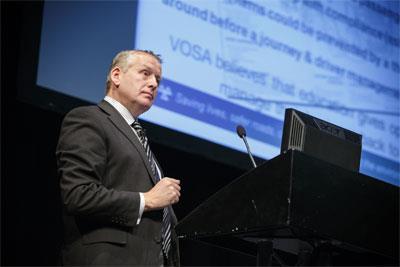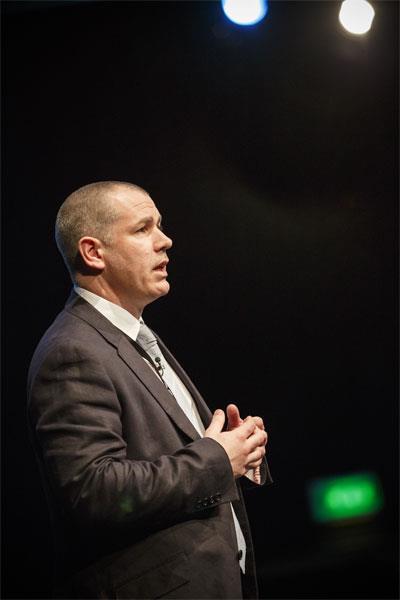
Over 400 delegates gathered at Nottingham University for the 2013 Microlise Transport Conference to hear a diverse mix of speakers – introduced by FairFuelUk spokesman Quentin Willson - discuss topics ranging from compliance and enforcement to using technology to improve operational efficiency.
Setting the scene, RHA chief executive Geoff Dunning said that in April 2012 there were 84,000 O-licences in the UK, down 20% in a decade, and there were 342,000 LGVs on UK roads, down 10% over 10 years. He predicted that the shrinkage of the industry would accelerate, with the number of operators falling another 20% and the UK LGV parc declining a further 10% in the next five years. But he forecast a continuing boom in the van fleet, which had grown by 38% in the last 10 years.
He called for self-certification of compliance with O-licence conditions so “good operators can just get on with it” and full privatisation of LGV annual testing. With the 2014 Driver CPC deadline fast approaching, Dunning warned that “getting good drivers” was already a problem that would only get worse. “There are lots of drivers out there with licences but who are unemployable,” he warned, urging operators to join the Think Logistics programme that aims to introduce careers in logistics to school leavers.
Alex Fiddes, executive director of next generation testing at Vosa (below), said the agency was using the Operator Compliance Risk Score (OCRS) to “make life uncomfortable” for non-compliant operators, and said there were two groups of operators who “want to be left alone”.
“There are those who are working hard to comply, but there are others who want to flout the legislation,” he said.

Fiddes said that while it was not Vosa’s job to tell operators how to do their jobs, it did produce lots of information and advice for transport managers.
Highlighting the poor performance of the UK LGV fleet when stopped for roadside inspections – 28% of trucks received a prohibition last year – Fiddes said 80% of defects such as faulty lights should have been picked up by the driver’s walkround check. “These are silly prohibitions,” he said.
Fiddes said Vosa’s programme to shift most LGV testing to private authorised testing facilities (ATFs) was progressing well, with 314 ATFs operating and another 148 in the pipeline.
Senior traffic commissioner Beverley Bell (main picture, top) said that despite perceptions that cowboy hauliers were ruining the industry, she said that apart from the odd exception “cowboys don’t really exist”. She said the majority of operators tried their best to comply but too many CPC holders and drivers still “don’t know the rules”.
She said new rules governing who could hold an Operator CPC were widely misunderstood.
“If you are having problems with the new regulation, don’t pretend you aren’t and hope your TC won’t notice,” she advised. “Get some help and write to us – you have six months to comply.”
She also called on operators to introduce random drugs testing for drivers – “the problem is quite bad”, she said.
Operators then took the platform to outline how the use of telematics and other technology was helping them improve efficiency and customer service.
Nick Hay, MD of Fowler Welch (below), warned however that technology “was not a silver bullet”, and that a successful implementation needed people at all levels in the organisation to buy in. “People and the company culture are the silver bullet,” he said. “Telematics is only the tool to measure it.”

He added operators needed to make a decent profit to enable them to invest in technology to reduce their carbon footprint. The Food and Drink Federation wants its members to cut CO2 emissions by 35% on 1990 levels by 2020 while achieving a 20% growth in output. “We need to play our part,” said Hay. “We now have telemetry across our fleet – but it costs a lot.”
Telematics have helped Fowler Welch cut its fuel consumption by 6% in 12 months, and reduced accident rates by 30%, Hay said.
Graham Lackey, MD of automotive transport specialist Brit European, described how converting trucks to dual fuel so they can run on natural gas and diesel was helping the company work towards its goal of a 35% cut in CO2 emissions in five years. Another goal was to insulate the operator and its customers from constantly increasing diesel prices. “We were embarrassed asking customers for a fuel surcharge,” he said. “We wanted to cut free of the fuel price escalator.”
Brit European is part of the Technology Strategy Board low carbon vehicle trial and received a £1.1m grant towards the £35,000 cost of Hardstaff gas conversions for its Mercedes-Benz Actros units. Lackey said that natural gas was a “no brainer” when it came to cutting CO2 emissions from long distance haulage - “dual fuel is the only technology for heavy trucks”.
Apart from a lack of infrastructure to refuel when away from base, Lackey said the biggest challenge to overcome was containment of gas on the vehicle. “When we said we wanted a range of 400 miles we got laughed at,” he recalled. “We were told it couldn’t be done – but it was.”
Brit European is using compressed rather than liquefied natural gas and has developed a portable mother-daughter refuelling station able to refuel 100 vehicles a day that is based at Crewe but can be relocated in 24 hours. With dual fuel, vehicles can run home on diesel if the gas runs out.
Lackey says that gas can substitute 55% to 60% of diesel use, cutting CO2 emissions by 15% to 18% and reducing fuel’s proportion of operating costs from 35% to 25%.
Simon Chamberlain, MD of Chamberlain Transport, told the conference how a combination of telematics and in-cab cameras had helped his fleet increase mpg by 3.5% despite an increase in vehicle weights. “Telematics alone don’t tell you want the driver is up to,” he said. “When we get a harsh braking incident we can look at the camera footage to see why it happened.”
Chamberlain uses the A to E driver performance score from the telematics system to pay a cash bonus to the best drivers and focus training on its under-performers. As a result it no longer employs any D or E rated drivers.
DHL and its customer bulk operator Openfield have worked together to develop an app to reduce the paperwork load on drivers. When collecting and tipping a load of grain, drivers often have to fill out four different pieces of paper, leading to delays of up to 14 days in completion of the financial transaction. “We wanted same day information on the weight collected and delivered to speed up payments,” said Jim Hotchin, director of operations at Openfield. “It also had to be cheap and simple to use.”
The solution, according to DHL’s VP IT – Strategy Planning and Innovation Ian Fisher was to develop an Android app that enables drivers to log in to the system, download details of the load and then send an electronic proof of delivery (PoD) when the load is tipped. All paperwork can be photographed and returned with the PoD.
According to Hotchin, the SmartPOD app has cut payment periods to three days and enabled farmers to be sent a message alerting them when the truck is an hour away so they are ready to send or receive the load.














